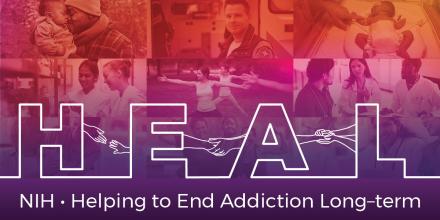ANN ARBOR — As the nation continues to battle an epidemic of addiction and overdose related to opioids and other drugs, several teams of University of Michigan researchers have received millions of dollars in new federal funding to address the issue head-on.

The grants will allow the teams to carry out innovative projects that will test new ways of understanding, preventing and treating addiction, and addressing pain through new approaches.
The funds were announced today by the National Institutes of Health as part of the Helping to End Addiction Long-term Initiative, or NIH HEAL Initiative. Launched in April 2018, the initiative aims to improve prevention and treatment strategies for opioid misuse and addiction and enhance pain management.
The grants to U-M are among 375 funding awards to teams in 41 states aimed at improving treatments for chronic pain, curbing the rates of opioid use disorder and overdose, and achieving long-term recovery from opioid addiction.
“It’s clear that a multipronged scientific approach is needed to reduce the risks of opioids, accelerate development of effective nonopioid therapies for pain, and provide more flexible and effective options for treating addiction to opioids,” said NIH Director Francis Collins, who launched the initiative in early 2018. “This unprecedented investment in the NIH HEAL Initiative demonstrates the commitment to reversing this devastating crisis.”
The grants to U-M teams are:
$12.6 million for comparative effectiveness studies of chronic back pain interventions
An interdisciplinary team of U-M researchers from the Michigan Medicine Chronic Pain and Fatigue Research Center and other departments, led by co-principal investigators Daniel Clauw of the departments of Anesthesiology, Internal Medicine and Psychiatry and Afton Hassett of the Department of Anesthesiology, have received a U19 grant of more than $12.6 million to fund the University of Michigan Mechanistic Research Center, as part of the broader Back Pain Consortium Research Program (BACPAC). The center will take patients with chronic low back pain and use a patient-centric, SMART design study to follow these individuals longitudinally as they try several different evidence-based therapies while mechanistic studies are overlaid to draw crucial inferences about what treatments will work in what patient endotypes. About 80% of adults experience low back pain at some point in their lives, with low-back pain being the most common cause of job-related disability.
“We are looking for solutions outside of opioids,” Hassett said. “These funds are a dream come true because they give us the opportunity to, in a really objective manner, look at the most commonly recommended interventions for patients and truly understand who they work for and how they are working.”
The U-M Center will share data from their patient populations with other members of the consortium, using advanced data mining techniques to develop more personalized interventions for chronic pain.
$6.9 million for emergency department-based opioid risk screening and virtual counseling for teens and young adults
Past U-M research has shown the power of asking patients about their drug use when they’re visiting a hospital for emergency care -- which may be one of their only interactions with the health care system. The approach uses a technique called motivational interviewing, a brief discussion designed to spur teens and young adults to cut back on their use or seek addiction help, when needed.
Based on the earlier success of this approach, the new funds will support a randomized controlled trial involving health coaches who will connect via video chat with young people during their emergency visits, and via secure web chat through a patient portal. The researchers are led by Maureen Walton, Ph.D. and Erin Bonar, Ph.D. of the Department of Psychiatry at Michigan Medicine, the U-M Addiction Center, and the U-M Injury Prevention Center. They will conduct the study at the Michigan Medicine emergency department including involvement by Rebecca Cunningham and Patrick Carter in Emergency Medicine, as well as a number of colleagues from across the university (Frederic Blow, Amy Bohnert, Sarah Clark, Kelley Kidwell, Cheryl King, Sean McCabe, Lisa Prosser & Terri Voepel-Lewis).
“Using health coaches and technology to interact with adolescents and young adults regarding their opioid use can allow for real-time tailoring within the rapidly changing opioid epidemic,” says Walton. “We hope this approach will produce a sustainable impact to prevent escalation of opioid misuse in young people.”
$4.7 million for telehealth-based treatment for adults with both opioid use disorder and chronic pain
This project aims to help people who have both chronic pain and opioid use disorder—a combination of conditions that can make it hard for them to overcome opioid problems, even when they’re taking proven addiction treatment medications.
Half of all people who currently receive medications for opioid use disorder (also called medication-assisted treatment) have chronic pain. And many people with both conditions live far from major medical centers, including veterans living far from VA hospitals.
The new project will test a telephone-based “talk therapy” pain management program in people with both conditions, to help them control their pain while staying on the medications that can treat their opioid use disorder. The project, led by Mark Ilgen and Lewei (Allison) Lin of the U-M Department of Psychiatry and VA Ann Arbor Healthcare System, will include a clinical trial in 100 veterans and 100 adults in the community, to look at the short- and long-term effects of the approach.
“We hope to provide information not only on the effectiveness of the intervention, but also the barriers and facilitators to future implementation of this approach for others,” said Ilgen, director of U-M Addiction Treatment Services. He and Lin are members of the U-M Addiction Center and U-M Institute for Healthcare Policy and Innovation.
$420,000 to study drug-related deaths among participants in the Monitoring the Future study
Since 1975, U-M researchers have carried out the Monitoring the Future study that asks tens of thousands of teens and young adults about their behaviors, attitudes and values, including their use of substances ranging from tobacco and alcohol to opioids and other drugs. Some of those surveyed while still in school take part in a long-term study, with surveys by mail.
The new funding will allow researchers to look at national death records for drug and opioid overdoses among members of this long-term group, and look back at their responses to past surveys about substance use. The researchers, led by Richard Miech of the U-M Institute for Social Research, will use their findings to identify potential target groups for drug overdose prevention. It will also allow them to look for factors that might break the link between adolescent drug use and later drug overdose mortality, such as social roles, quitting smoking and low depressive affect.
“We are excited by this opportunity to identify the factors that prevent drug overdose—information that will save lives,” said Miech, who leads the Monitoring the Future Study MAIN study, which is funded by the National Institute on Drug Abuse, part of the National Institutes of Health.
$900,000 to design and test an intervention to support effective delivery of an evidence-based health curriculum for drug use prevention in high school
Interventions rarely achieve public health outcomes, such as reduced drug use, without implementation support. Andria Eisman, research assistant professor in health behavior and health education at the U-M School of Public Health, focuses on designing strategies that are both effective and cost-effective. For this project, she plans to work with community partners to tailor the curriculum specifically to meet the needs of youth who have experienced trauma and disadvantage and are at risk for drug use and its consequences.
These projects are just the latest in a wide range of opioid-related research and innovation that U-M teams are engaged in. Several teams received HEAL Initiative funding in 2018 as well. To see all the opioid-related work going on at U-M, visit U-M Opioid Solutions.
This article was originally posted here: https://www.uofmhealth.org/news/archive/201909/u-m-teams-receive-255-million-opioid-related-prevention-and



